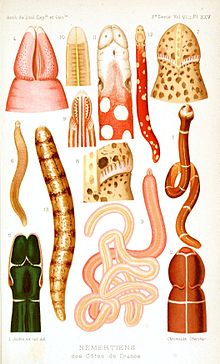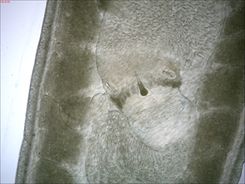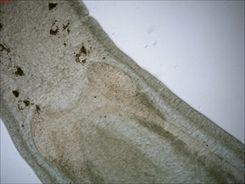Nemertea
| Nemertea Temporal range: Possible Ordovician and Carboniferous records
| |
|---|---|

| |
| Scientific classification | |
| Domain: | Eukaryota |
| Kingdom: | Animalia |
| Subkingdom: | Eumetazoa |
| Clade: | ParaHoxozoa |
| Clade: | Bilateria |
| Clade: | Nephrozoa |
| (unranked): | Protostomia |
| (unranked): | Spiralia |
| Superphylum: | Lophotrochozoa |
| Phylum: | Nemertea Schultze , 1851
|
| Classes | |
| Synonyms [1] | |
|
Nemertini | |
Nemertea is a phylum of animals also known as ribbon worms or proboscis worms, consisting of 1300 known species.[2][3] Most ribbon worms are very slim, usually only a few millimeters wide, although a few have relatively short but wide bodies. Many have patterns of yellow, orange, red and green coloration. The foregut, stomach and intestine run a little below the midline of the body, the
The brain is a ring of four
All nemerteans move slowly, using their external
In most species the sexes are separate, but all the freshwater species are
Traditional
.History
In 1555 Olaus Magnus wrote of a marine worm which was apparently 17.76 metres (58.3 ft) long ("40 cubits"), about the width of a child's arm, and whose touch made a hand swell. William Borlase wrote in 1758 of a "sea long worm", and in 1770 Gunnerus wrote a formal description of this animal, which he called Ascaris longissima. Its current name, Lineus longissimus, was first used in 1806 by Sowerby.[4] In 1995, a total of 1,149 species had been described and grouped into 250 genera.[5]
Nemertea are named after the Greek sea-
Description
Body structure and major cavities
The typical nemertean body is very thin in proportion to its length.[9] The smallest are a few millimeters long,[10] most are less than 20 centimetres (7.9 in), and several exceed 1 metre (3.3 ft). The longest animal ever found, at 54 metres (177 ft) long, may be a specimen of Lineus longissimus,[9] Ruppert, Fox and Barnes refer to a Lineus longissimus 54 metres (177 ft) long, washed ashore after a storm off St Andrews in Scotland.[11] Other estimates are about 30 metres (98 ft).[12] Zoologists find it extremely difficult to measure this species.[13] For comparison:
- The longest recorded blue whale was 33.58 metres (110.2 ft).[14]
- The dinosaurs Argentinosaurus and Patagotitan are estimated at approximately 35 metres (115 ft) and 31 metres (102 ft) respectively.[15]
- A specimen of the Arctic giant jellyfish Cyanea capillata arctica was 36.5 metres (120 ft) long.[16]
L. longissimus, however, is usually only a few millimeters wide.[17] The bodies of most nemerteans can stretch a lot, up to 10 times their resting length in some species,[17][9] but reduce their length to 50% and increase their width to 300% when disturbed.[12] A few have relatively short but wide bodies, for example Malacobdella grossa is up to 3.5 centimetres (1.4 in) long and 1 centimetre (0.39 in) wide,[9][18] and some of these are much less stretchy.[17] Smaller nemerteans are approximately cylindrical, but larger species are flattened dorso-ventrally. Many have visible patterns in various combinations of yellow, orange, red and green.[9]
The outermost layer of the body has no
They are unsegmented, but at least one species, Annulonemertes minusculus, is segmented. But this is assumed to be a derived trait. The segmentation does not include the coelom and body wall, and is therefore referred to as pseudosegmentation.[20][21]
The mouth is ventral and a little behind the front of the body. The foregut, stomach and intestine run a little below the midline of the body and the
Proboscis and feeding
The proboscis is an infolding of the body wall, and sits in the rhynchocoel when inactive.[10] When muscles in the wall of the rhynchocoel compress the fluid inside, the pressure makes the proboscis jump inside-out along a canal called the rhynchodeum and through an orifice, the proboscis pore. The proboscis has a muscle which attaches to the back of the rhynchocoel, can stretch up to 30 times its inactive length and acts to retract the proboscis.[9]

The proboscis of the class Anopla exits from an orifice which is separate from the mouth,[9] coils around the prey and immobilizes it by sticky, toxic secretions.[22] The Anopla can attack as soon as the prey moves into the range of the proboscis.[23] Some Anopla have branched proboscises which can be described as "a mass of sticky spaghetti".[9] The animal then draws its prey into its mouth.[10]

In most of the class Enopla, the proboscis exits from a common orifice of the rhynchocoel and mouth. A typical member of this class has a stylet, a calcareous barb,[9] with which the animal stabs the prey many times to inject toxins and digestive secretions. The prey is then swallowed whole or, after partial digestion, its tissues are sucked into the mouth.[22] The stylet is attached about one-third of the distance from the end of the everted proboscis, which extends only enough to expose the stylet. On either side of the active stylet are sacs containing back-up stylets to replace the active one as the animal grows or an active one is lost.[9] Instead of one stylet, the Polystilifera have a pad that bears many tiny stylets, and these animals have separate orifices for the proboscis and mouth, unlike other Enopla.[24][25] The Enopla can only attack after contacting the prey.[23]
Some nemerteans, such as L. longissimus, absorb organic food in solution through their skins, which may make the long, slim bodies an advantage.
Respiration and circulatory system
Nemerteans lack specialized
In the simplest type of circulatory system, two lateral vessels are joined at the ends to form a loop. However, many species have additional long-wise and cross-wise vessels. There is no heart nor pumping vessels,[30] and the flow of fluid depends on contraction of both the vessels and the body wall's muscles. In some species, circulation is intermittent, and fluid ebbs and flows in the long-wise vessels.[27] The fluid in the vessels is usually colorless, but in some species it contains cells that are yellow, orange, green or red. The red type contain hemoglobin and carry oxygen, but the function of the other pigments is unknown.[27]
Excretion

Nemertea use organs called
Nervous-system and senses

The
Some species have paired
Paranemertes peregrina, which feeds on polychaetes, can follow the prey's trails of mucus, and find its burrow by backtracking along its own trail of mucus.[22]
Movement

Nemerteans generally move slowly,[10] though they have occasionally been documented to successfully prey on spiders or insects.[37] Most nemerteans use their external cilia to glide on surfaces on a trail of slime, some of which is produced by glands in the head. Larger species use muscular waves to crawl, and some aquatic species swim by dorso-ventral undulations. Some species burrow by means of muscular peristalsis, and have powerful muscles.[9] Some species of the suborder Monostilifera, whose proboscis have one active stylet, move by extending the proboscis, sticking it to an object and pulling the animal toward the object.[24]
Reproduction and life-cycle
Larger species often break up when stimulated, and the fragments often grow into full individuals. Some species fragment routinely and even parts near the tail can grow full bodies.
Nemerteans often have numerous temporary
The
The species Paranemertes peregrina has been reported as having a life span of around 18 months.[34]
Ecological significance


Most nemerteans are marine animals that burrow in sediments, lurk in crevices between shells, stones or the
The terrestrial Argonemertes dendyi is a native of
Most are
Near San Francisco the nemertean Carcinonemertes errans has consumed about 55% of the total egg production of its host, the dungeness crab Metacarcinus magister. C. errans is considered a significant factor in the collapse of the dungeness crab fishery.[23] Other coastal nemerteans have devastated clam beds.[9]
The few predators on nemerteans include bottom-feeding fish, some sea birds, a few invertebrates including horseshoe crabs, and other nemerteans.[9] Nemerteans' skins secrete toxins that deter many predators, but some crabs may clean nemerteans with one claw before eating them.[28] The American Cerebratulus lacteus and the South African Polybrachiorhynchus dayi, both called "tapeworms" in their respective localities, are sold as fish bait.[9]
Taxonomy
Traditional taxonomic classification has divided the group into two classes and four orders:
- Class Anopla ("unarmed"). Includes animals with proboscis without stylet, and a mouth underneath and behind the brain.[24]
- burrowing by peristalsis.[24]
- Order Heteronemertea. Comprises about 400 species. The majority are marine, but three are freshwater. Their body-wall muscles are disposed in four layers, alternately circular and length-wise starting from the outermost layer. The order includes the strongest swimmers. Two genera have branched proboscises.[24]
- Class Bdellonemertea. Their mouth is located underneath and ahead of the brain. Their main nerve cords run inside body-wall muscles.[24]
- Order
- Order pelagic sea water, in freshwater and on land. They feed by commensalism and parasitism, and are armed with stylet(s)[24]
- Suborder Monostilifera. Includes 500 species with a single central stylet. Some use the stylet for locomotion as well as for capturing prey.[24]
- Suborder Polystilifera. Includes about 100 pelagic and 50 benthic species. Their pads bear many tiny stylets.[24]
Recent molecular phylogenetic studies divided the group into two superclasses, three classes, and eight orders:[45]
- Superclass Pronemertea
- Class Palaeonemertea
- Order Carinomiformes
- Order Tubulaniformes
- Order Archinemertea
- Class Palaeonemertea
- Superclass Neonemertea
- Class Pilidiophora
- Order Hubrechtiiformes
- Order Heteronemertea
- Class Hoplonemertea (= Enopla)
- Order Polystilifera
- Order Monostilifera (includes Bdellonemertea)
- Class Pilidiophora
- incertae sedis
- Order Arhynchonemertea (provisionally has been separated its own class Arhynchocoela in 1995)
Evolutionary history
Fossil record
As nemerteans are mostly soft-bodied, one would expect fossils of them to be extremely rare.[10][44] Knaust (2010) reported nemertean fossils and traces from the Middle Triassic of Germany.[46] One might expect the stylet of a nemertean to be fossilized, since it is made of the mineral calcium phosphate, but no fossilized stylets have been found.[10][44]
The
Knaust & Desrochers (2019) reported fossils of vermiform organisms with a wide range of morphologies occurring on bedding planes from the Late Ordovician (Katian) Vauréal Formation (Canada). In the specimens preserving the anterior end of the body, this end is pointed or rounded, bearing a rhynchocoel with the proboscis, which is characteristic for nemerteans. The authors attributed these fossils to nemerteans and interpreted them as the oldest record of the group reported so far. However, Knaust & Desrochers cautioned that partly preserved putative nemertean fossils might ultimately turn out to be fossils of turbellarians or annelids.[48]
It has been suggested that
Within Nemertea
| Nemertea |
| ||||||||||||||||||
There is no doubt that the phylum Nemertea is
While Ruppert, Fox and Barnes (2004) treat the Palaeonemertea as monophyletic,
Relationships with other phyla
English-language writings have conventionally treated nemerteans as acoelomate bilaterians that are most closely related to flatworms (Platyhelminthes). These pre-
According to more recent analyses, in the development of nemertean embryos, ecto
| Bilateria |
| |||||||||||||||||||||||||||||||||||||||||||||||||||||||||
Nemerteans' affinities with Annelida (including Echiura,
Most
See also
- Emplectonema neesii
- Lineus longissimus
- Parborlasia corrugatus
Notes
References
- ^ ISBN 978-3-11-010661-9.
- ^ "Nemertea". Integrated Taxonomic Information System. Retrieved February 18, 2011.
- S2CID 249434440.
- ISSN 0260-9541.
- ^ .
- ISBN 978-0-632-04761-1. Retrieved 27 Jan 2011.
- PMID 19129141.
- PMID 17051477.
- ^ ISBN 978-0-03-025982-1.)
{{cite book}}: CS1 maint: multiple names: authors list (link - ^ ISBN 978-0-19-553941-7.
- ISBN 978-0-85112-658-6.
- ^ Woods Hole, Massachusetts: The Marine Biological Laboratory. Archived from the originalon 2011-09-27. Retrieved 30 March 2011.
- ISBN 978-0-7614-7418-0. Retrieved 30 March 2011.
- ISBN 978-1-84537-820-2. Retrieved 27 Jan 2011.
- (PDF) from the original on 2022-10-10.
- ISBN 978-1-4027-5623-8. Retrieved 27 Jan 2011.
- ^ ISBN 978-0-521-85736-9. Retrieved 31 Jan 2011.
- ISBN 978-0-8047-1045-9. Retrieved 26 Jan 2011.
- S2CID 206787592.
- PMID 17686756.
- ISBN 978-0-691-19706-7.
- ^ ISBN 978-0-03-025982-1.)
{{cite book}}: CS1 maint: multiple names: authors list (link - ^ .
- ^ ISBN 978-0-03-025982-1.)
{{cite book}}: CS1 maint: multiple names: authors list (link - ISBN 978-0-520-23939-5. Retrieved 4 Feb 2011.
- ISBN 978-0-520-00750-5. Retrieved 22 February 2011.
- ^ ISBN 978-0-03-025982-1.)
{{cite book}}: CS1 maint: multiple names: authors list (link - ^ )
- PMID 19247975.
- ISBN 978-0-19-553941-7.
- ISBN 978-0-03-025982-1.)
{{cite book}}: CS1 maint: multiple names: authors list (link - ^ ISBN 978-0-03-025982-1.)
{{cite book}}: CS1 maint: multiple names: authors list (link - ^ PMID 21558236.
- ^ ISBN 978-0-03-056747-6.
- ISBN 978-0-495-01034-0. Retrieved 31 Jan 2011.
- ISBN 978-0-495-01034-0. Retrieved 31 Jan 2011.
- PMID 28963523.
- ^ ISBN 978-0-03-025982-1.
- ^ A phylum-wide survey reveals multiple independent gains of head regeneration in Nemertea
- ^ "Gonoduct – Medical Definition". Merriam-Webster, Incorporated. Retrieved 31 January 2011.
- PMID 25888821.
- ^ Howarth, Francis G.; Janet Moore (1983). "The land nemertine Argonemertes dendyi (Dakin) in Hawaii (Nemertinea: Hoplonemertinea: Prosorhochmidae)" (PDF). Pacific Science. 37 (2): 141–144. Archived from the original (PDF) on 2018-11-04. Retrieved 2011-02-17.
- PMID 28963523.
- ^ a b c d e f Ben Waggoner; Allen G. Collins (June 13, 2001). "Introduction to the Nemertini". University of California, Berkeley. Archived from the original on 10 December 2010. Retrieved 3 Feb 2011.
- S2CID 239872311.
- .
- ISBN 978-0-08-043404-9. Retrieved 11 Feb 2011.
- S2CID 134814852.
- JSTOR 1303083.
- ISBN 978-0-19-850681-2. Retrieved 11 Feb 2011.
- ^ ISBN 978-0-03-025982-1.)
{{cite book}}: CS1 maint: multiple names: authors list (link - ^ RFB 2004 pp. 2-3
- ^ PMID 12639321.
- ^ PMID 21708766.
- ISBN 978-0-03-025982-1.
- ^ (PDF) from the original on 2022-10-10.
- PMID 17411434.
- ^ PMID 18192183.
- S2CID 205247296.
